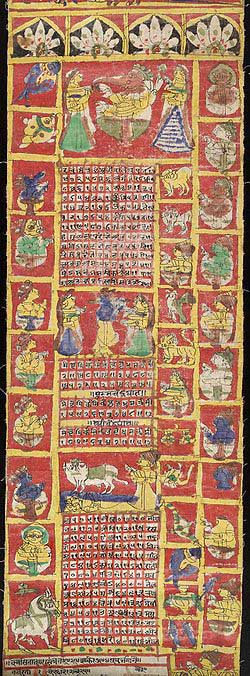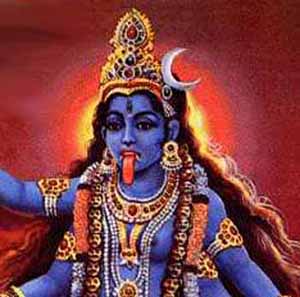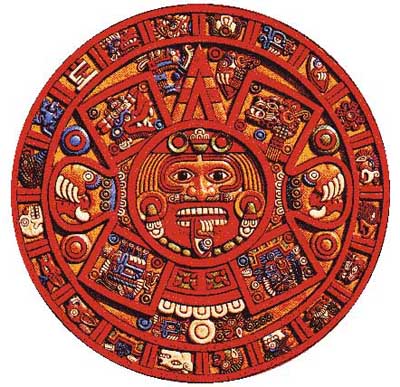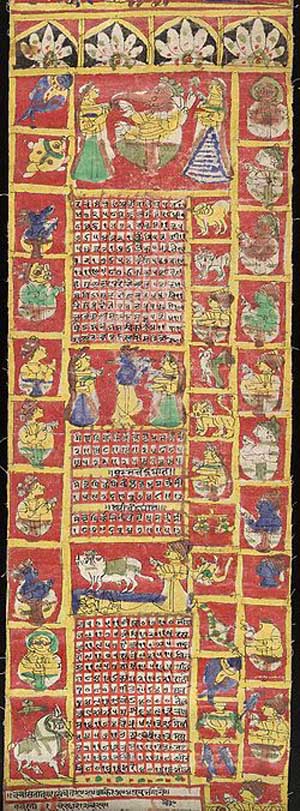

The hindu calendar used in ancient times has undergone many changes in the process of regionalization, and today there are several regional Indian calendars, as well as an Indian national calendar. Nepali calendar, Bengali calendar, Malayalam calendar, Tamil calendar, Telugu calendar, Kannada calendar etc. are some prominent regional Hindu calendars.
Most of these calendars are inherited from a system first enunciated in Vedanga Jyotisha of Lagadha, a late BCE adjunct to the Vedas, standardized in the Surya Siddhanta (3rd century CE) and subsequently reformed by astronomers such as Aryabhata (499 CE), Varahamihira (6th c. CE), and Bhaskara (12th c. CE). Differences and regional variations abound in these computations, but the following is a general overview of Hindu lunisolar calendar.
The oldest system, in many respects the basis of the classical one, is known from texts of about 1000 BC. It divides an approximate solar year of 360 days into 12 lunar months of 27 (according to the early Vedic text Taittiriya Samhita 4.4.10.1-3) or 28 (according to the Atharvaveda, the fourth of the Vedas, 19.7.1.) days. The resulting discrepancy was resolved by the intercalation of a leap month every 60 months.
Time was reckoned by the position marked off in constellations on the ecliptic in which the Moon rises daily in the course of one lunation (the period from New Moon to New Moon) and the Sun rises monthly in the course of one year.
These constellations (naksatra) each measure an arc of 13 20' of the ecliptic circle. The positions of the Moon were directly observable, and those of the Sun inferred from the Moon's position at Full Moon, when the Sun is on the opposite side of the Moon. The position of the Sun at midnight was calculated from the naksatra that culminated on the meridian at that time, the Sun then being in opposition to that naksatra.
The year was divided into three thirds of four months, each of which would be introduced by a special religious rite, the caturmasya (four-month rite). Each of these periods was further divided into two parts (seasons or rtu): spring (vasanta), from mid-March until mid-May; summer (grisma), from mid-May until mid-July; the rains (varsa), from mid-July until mid-September; autumn (sarad ), from mid-September until mid-November; winter (hemanta), from mid-November until mid-January; and the dews (sisira), from mid-January until mid-March.
The spring months in early times were Madhu and Madhava, the summer months Sukra and Suci, the rainy months Nabhas and Nabhasya, the autumn months Isa and Urja, the winter months Sahas and Sahasya, and the dewy months Tapas and Tapasya.
The month, counted from Full Moon to Full Moon, was divided into two halves (paksa, "wing") of waning (krsna) and waxing (sukla) Moon, and a special ritual (darsapurnamasa, "new and full moon rites") was prescribed on the days of New Moon (amavasya) and Full Moon (purnimas).
The month had theoretically 30 days (tithi), and the day (divasa) 30 hours (muhurta).
This picture is essentially confirmed by the first treatise on time reckoning, the Jyotisa-vedanga ("Vedic auxiliary [text] concerning the luminaries") of about 100 BC, which adds a larger unit of five years (yuga) to the divisions. A further old distinction is that of two year moieties, the uttarayana ("northern course"), when the Sun has passed the spring equinox and rises every morning farther north, and the daksinayana ("southern course"), when it has passed the autumnal equinox and rises progressively farther south.
In its classic form (Surya-siddhanta, 4th century AD) the calendar continues from the one above with some refinements. With the influence of Hellenism, Greek and Mesopotamian astronomy and astrology were introduced.
Though astronomy and time reckoning previously were dictated by the requirements of rituals, the time of which had to be fixed correctly, and not for purposes of divination, the new astrology came into vogue for casting horoscopes and making predictions.
Zodiacal time measurement was now used side by side with the older naksatra one. The naksatra section of the ecliptic (13 20') was divided into four parts of 3 20' each; thus, two full naksatras and a quarter of one make up one zodiac period, or sign (30).
The year began with the entry of the Sun (samkranti) in the sign of Aries. The names of the signs (rasi) were taken over and mostly translated into Sanskrit: mesa ("ram," Aries), vrsabha ("bull," Taurus), mithuna ("pair," Gemini), karkata ("crab," Cancer), simha ("lion," Leo), kanya ("maiden," Virgo), tula ("scale," Libra), vrscika ("scorpion," Scorpius), dhanus ("bow," Sagittarius), makara ("crocodile," Capricornus), kumbha ("water jar," Aquarius), mina ("fish," Pisces).
The precession of the vernal equinox from the Sun's entry into Aries to some point in Pisces, with similar consequences for the summer solstice, autumnal equinox, and winter solstice, has led to two different methods of calculating the samkranti (entry) of the Sun into a sign. The precession (ayana) is not accounted for in the nirayana system (without ayana), which thus dates the actual samkranti correctly but identifies it wrongly with the equinox or solstice, and the sayana system (with ayana), which thus dates the equinox and solstice correctly but identifies it wrongly with the samkranti.
While the solar system has extreme importance for astrology, which, it is claimed, governs a person's life as an individual or part of a social system, the sacred time continues to be reckoned by the lunar naksatra system. The lunar day (tithi), a 30th part of the lunar month, remains the basic unit. Thus, as the lunar month is only about 29 1/2 solar days, the tithi does not coincide with the natural day (ahoratra). The convention is that that tithi is in force for the natural day that happened to occur at the dawn of that day. Therefore, a tithi beginning after dawn one day and expiring before dawn the next day is eliminated, not being counted in that month, and there is a break in the day sequence.
The names of the naksatras, to which correspond the tithis in the monthly lunar cycle and segments of months in the annual solar cycle, are derived from the constellations on the horizon at that time and have remained the same. The names of the months have changed: Caitra (March-April), Vaisakha (April-May), Jyaistha (May-June), Asadha (June-July), Sravana (July-August), Bhadrapada (August-September), Asvina (September-October), Karttika (October-November), Margasirsa (November-December), Pausa (December-January), Magha (January-February), and Phalguna (February-March).
In this calendar the date of an event takes the following form: month, fortnight (either waning or waxing Moon), name (usually the number) of the tithi in that fortnight, and the year of that era which the writer follows. Identification, particularly of the tithi, is often quite complicated, since it requires knowledge of the time of sunrise on that day and which 30th of the lunar month was in force then. Eventually, India also adopted the seven-day week (saptaha) from the West and named the days after the corresponding planets: Sunday after the Sun, ravivara; Monday after the Moon, somavara; Tuesday after Mars, mangalavara; Wednesday after Mercury, budhavara; Thursday after Jupiter, brhaspativara; Friday after Venus, sukravara; and Saturday after Saturn, sanivara.
A further refinement of the calendar was the introduction into dating of the place of a year according to its position in relation to the orbital revolution of the planet Jupiter, called brhaspati in Sanskrit. Jupiter has a sidereal period (its movement with respect to the "fixed" stars) of 11 years, 314 days, and 839 minutes, so in nearly 12 years it is back into conjunction with those stars from which it began its orbit. Its synodic period brings it into conjunction with the Sun every 398 days and 88 minutes, a little more than a year.
Thus, Jupiter in a period of almost 12 years passes about the same series of naksatras that the Sun passes in one year and, in a year, about the same naksatras as the Sun in a month. A year then can be dated as the month of a 12-year cycle of Jupiter, and the date is given as, for example, grand month of Caitra. This is extended to a unit of five cycles, or the 60-year cycle of Jupiter (brhaspaticakra), and a "century" of 60 years is formed. This system is known from the 6th century AD onward.
At the other end of the scale, more precision is brought to the day. Every tithi is divided into two halves, called karanas. The natural day is divided into units ranging from a vipala (0.4 second) to a ghatik) (24 minutes) and an "hour" (muhurta) of 48 minutes; the full natural day has 30 such hours. The day starts at dawn; the first six ghatikas are early morning, the second set of six midmorning, the third midday, the fourth afternoon, the fifth evening. Night lasts through three units (yama) of time: six ghatikas after sundown, or early night; two of midnight; and four of dawn.
There are a few secular state holidays (e.g., Independence Day) and some solar holidays, such as the entry of the Sun into the sign of Aries (mesa-samkranti), marking the beginning of the new astrological year; the Sun's entry into the sign of Capricornus (makara-samkranti), which marks the winter solstice but has coalesced with a hoary harvest festival, which in southern India is very widely celebrated as the Pongal festival; and the mahavisuva day, which is New Year's Eve. But all other important festivals are based on the lunar calendar.
As a result of the high specialization of deities and events celebrated in different regions, there are hundreds of such festivals, most of which are observed in smaller areas, though some have followings throughout India. A highly selective list of the major ones, national and regional, follows. Ramanavami ("ninth of Rama"), on Caitra S. (= sukla, "waxing fortnight") 9, celebrates the birth of Rama.
Rathayatra ("pilgrimage of the chariot"), Asadha S. 2, is the famous Juggernaut (Jagannatha) festival of the temple complex at Puri, Orissa. Janmastami ("eighth day of the birth"), Sravana K. (= krsna, "waning fortnight") 8, is the birthday of the god Krsna. Ganesacaturthi ("fourth of Ganesa"), Bhadrapada S. 4, is observed in honour of the elephant-headed god Ganhsa, a particular favorite of Maharashtra. Durga-puja ("homage to DurgaT), Asvina S. 7-10, is special to Bengal, in honor of the destructive and creative goddess Durga. Dasahra ("ten days"), or Dussera, Asvina 7-10, is parallel to Durga-puja, celebrating Rama's victory over Ravana, and traditionally the beginning of the warring season.
Laksmipuja ("homage to Laksmi"), Asvina S. 15, is the date on which commercial books are closed, new annual records begun, and business paraphernalia honored; for Laksmi is the goddess of good fortune.
Dipavali, Diwali ("strings of lights"), Karttika K. 15 and S. 1, is the festival of lights, when light is carried from the waning to the waxing fortnight and presents are exchanged. Maha-sivaratri ("great night of Siva"), Magha K. 13, is when the dangerous but, if placated, benevolent god Siva is honored on the blackest night of the month. Holi (name of a demoness), Phalguna S. 14, is a fertility and role-changing festival, scene of great fun-poking at superiors. Dolayatra ("swing festival"), Phalguna S. 15, is the scene of the famous hook-swinging rites of Orissa. Guru Nanak Jayanti, Karttika S. 15, is the birthday of Nanak, the founder of the sect of Sikhism.
Not before the first century BC is there any evidence that the years of events were recorded in well-defined eras, whether by cycles, as the Olympic Games in Greece and the tenures of consuls in Rome, or the Roman year dating from the foundation of the city. Perhaps under outside influence, the recording of eras was begun at various times, but these were without universal appeal, and few have remained influential.
Among those are (1) the Vikrama era, begun 58 BC; (2) the Saka era, begun AD 78 (these two are the most commonly used); (3) the Gupta era, begun AD 320; (4) the Harsa era, begun AD 606. All these were dated from some significant historical event.
Of more mythological interest is the Kali era (Kali being the latest and most decadent period in the system of the four Yugas), which is thought to have started either at dawn on February 18, 3102 BC, or at midnight between February 17 and 18 in that year.
The Hindu calendar used in ancient Vedic times has undergone many changes in the process of regionalization, and today there are several regional Indian calendars, as well as an Indian national calendar.
Mostly, these are inherited from a system first enunciated in Jyotish Vedanga (one of the six adjuncts to the Vedas, 12th to 14th century BC), standardized in the Surya Siddhanta (3rd century) and subsequently reformed by astronomers such as Aryabhata (499), Varahamihira (6th century), and Bhaskara (12th century). There are differences and regional variations abound in these computations, but the following is a general overview.
Hindu Calendars Wikipedia

In the "Brahma-Vaivarta Purana", Lord Krishna tells Ganga Devi that a Golden Age will come in the Kali Yuga - one of the four stages of development that the world goes through as part of the cycle of eras, as described in Hindu scriptures. Lord Krishna predicted that this Golden Age will start 5,000 years after the beginning of the Kali Yuga, and will last for 10,000 years.
Yuga in Hindu philosophy is the name of an 'epoch' or 'era' within a cycle of four ages. These are the Satya Yuga (or Krita Yuga), the Treta Yuga, the Dvapara Yuga and finally the Kali Yuga. According to Hindu cosmology, life in the universe is created, destroyed once every 4.1 to 8.2 billion years, which is one full day (day and night) for Brahma. The lifetime of a Brahma himself may be 311 trillion and 40 Billion years. The cycles are said to repeat like the seasons, waxing and waning within a greater time-cycle of the creation and destruction of the universe. Like Summer, Spring, Winter and Autumn, each yuga involves stages or gradual changes which the earth and the consciousness of mankind goes through as a whole. A complete yuga cycle from a high Golden Age of enlightenment to a Dark Age and back again is said to be caused by the solar system's motion around a central sun.

Mayan Calendar (above) Matches the Hindu Calendar

It is interesting that this prediction of the emergence of a new world is prophesied to appear about the same time that the Mayans predicted it to come. The Mayan calendar began with the Fifth Great Cycle in 3114 BC and will end on December 21, 2012 AD. The Hindu Kali Yuga calendar began on 18 February 3102 B.C. There is only a difference of 12 years between the Hindu's beginning of the Kali Yuga and the Mayan's beginning of the Fifth Great Cycle.
The Golden Age Could Begin in 2012
The ancient Hindus mainly used lunar calendars but also used solar calendars. If an average lunar year equals 354.36 days, then this would be about 5270 lunar years from the time when the Kali Yuga started until 21 Dec 2012. This is the same year that the Mayans predict rebirth of our planet. It is also about 5113 solar years of 365.24 days per year, and is day number 1,867,817 into the Kali Yuga. By either solar or lunar years, we are over 5,000 years into the Kali Yuga and it is time for Lord Krishna's prophecy to happen according to the ancient Hindu scriptures. Lord Krishna's Golden Age could easily begin in 2012!
Mayan Prophecy Matches Hindu Prophecy
It is amazing that both calendars began at about the same time over 5,000 years ago and both calendars predict a totally new world and/or golden age after about 5,000 years into their calendars! We are definitely on to something with these Mayan and Hindu 2012 predictions. Historically, this is an amazing fact since these two ancient cultures did not have any contact.
The end of Kali Yuga occurs "When flowers will be begot within flowers, and fruits within fruits, then will the Yuga come to an end. And the clouds will pour rain unseasonably when the end of the Yuga approaches."
ANCIENT AND LOST CIVILIZATIONS INDEX